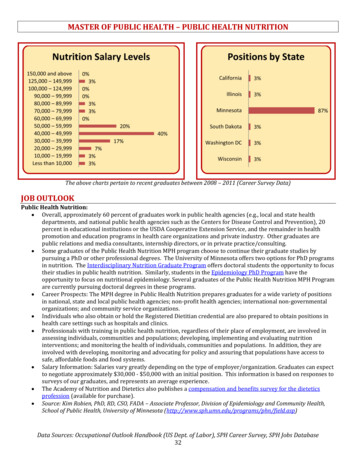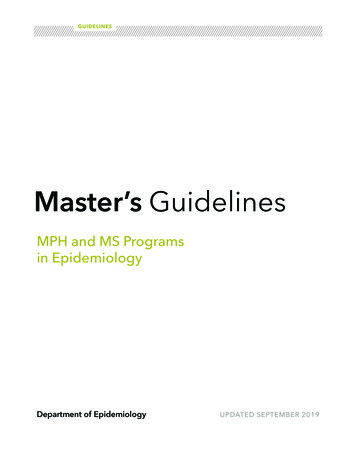
Transcription
MASTER OF PUBLIC HEALTH – PUBLIC HEALTH NUTRITIONThe above charts pertain to recent graduates between 2008 – 2011 (Career Survey Data)JOB OUTLOOKPublic Health Nutrition: Overall, approximately 60 percent of graduates work in public health agencies (e.g., local and state healthdepartments, and national public health agencies such as the Centers for Disease Control and Prevention), 20percent in educational institutions or the USDA Cooperative Extension Service, and the remainder in healthpromotion and education programs in health care organizations and private industry. Other graduates arepublic relations and media consultants, internship directors, or in private practice/consulting. Some graduates of the Public Health Nutrition MPH program choose to continue their graduate studies bypursuing a PhD or other professional degrees. The University of Minnesota offers two options for PhD programsin nutrition. The Interdisciplinary Nutrition Graduate Program offers doctoral students the opportunity to focustheir studies in public health nutrition. Similarly, students in the Epidemiology PhD Program have theopportunity to focus on nutritional epidemiology. Several graduates of the Public Health Nutrition MPH Programare currently pursuing doctoral degrees in these programs. Career Prospects: The MPH degree in Public Health Nutrition prepares graduates for a wide variety of positionsin national, state and local public health agencies; non-profit health agencies; international non-governmentalorganizations; and community service organizations. Individuals who also obtain or hold the Registered Dietitian credential are also prepared to obtain positions inhealth care settings such as hospitals and clinics. Professionals with training in public health nutrition, regardless of their place of employment, are involved inassessing individuals, communities and populations; developing, implementing and evaluating nutritioninterventions; and monitoring the health of individuals, communities and populations. In addition, they areinvolved with developing, monitoring and advocating for policy and assuring that populations have access tosafe, affordable foods and food systems. Salary Information: Salaries vary greatly depending on the type of employer/organization. Graduates can expectto negotiate approximately 30,000 - 50,000 with an initial position. This information is based on responses tosurveys of our graduates, and represents an average experience. The Academy of Nutrition and Dietetics also publishes a compensation and benefits survey for the dieteticsprofession (available for purchase). Source: Kim Robien, PhD, RD, CSO, FADA – Associate Professor, Division of Epidemiology and Community Health,School of Public Health, University of Minnesota a Sources: Occupational Outlook Handbook (US Dept. of Labor), SPH Career Survey, SPH Jobs Database32
Registered Dietitians: Most jobs are in our graduates obtained are in the areas of Women, Infants, and Children (WIC) Programs,Extension Services, Supplemental Nutrition Assistance Programs (SNAP Education), and other food assistanceprograms. Additional job opportunities exist in hospitals, nursing care facilities, outpatient care centers, andoffices of physicians or other health practitioners. Dietitians and nutritionists need at least a bachelor's degree;licensure, certification, or registration requirements vary by State. Applicants with specialized training, anadvanced degree, or certifications beyond the particular State's minimum requirement should enjoy the best jobopportunities. Dietitians and nutritionists held about 60,300 jobs in 2008. More than half of all jobs were in hospitals, nursingcare facilities, outpatient care centers, or offices of physicians and other health practitioners. State and localgovernment agencies provided additional jobs—mostly in correctional facilities, health departments, and otherpublic-health-related areas. Some dietitians and nutritionists were employed in special food services, anindustry made up of firms providing food services on contract to facilities such as colleges and universities,airlines, correctional facilities, and company cafeterias. Other jobs were in public and private educationalservices, community care facilities for the elderly (which includes assisted-living facilities), individual and familyservices, home healthcare services, and the Federal Government—mostly in the U.S. Department of VeteransAffairs. Some dietitians were self-employed, working as consultants to facilities such as hospitals and nursingcare facilities or providing dietary counseling to individuals. Employment change: Employment of dietitians and nutritionists is expected to increase 9 percent during the2008-18 projection decade, about as fast as the average for all occupations. Job growth will result from anincreasing emphasis on disease prevention through improved dietary habits. A growing and aging populationwill boost demand for nutritional counseling and treatment in hospitals, residential care facilities, schools,prisons, community health programs, and home healthcare agencies. Public interest in nutrition and increasedemphasis on health education and prudent lifestyles also will spur demand, especially in food servicemanagement. Also, with increased public awareness of obesity and diabetes, Medicare coverage has beenexpanded to include medical nutrition therapy for renal and diabetic patients, creating job growth for dietitiansand nutritionists specializing in those diseases. Employment growth, however, may be constrained if some employers substitute other workers, such as healtheducators, food service managers, and dietetic technicians, to do work related to nutrition. Also, demand fornutritional therapy services is related to the ability of patients to pay, either out-of-pocket or through healthinsurance, and although more insurance plans now cover nutritional therapy services, the extent of suchcoverage varies among plans. Growth may be curbed by limitations on insurance reimbursement for dieteticservices. Hospitals will continue to employ a large number of dietitians and nutritionists to provide medical nutritionaltherapy and plan meals. But hospitals also will continue to contract with outside agencies for food service andmove medical nutritional therapy to outpatient care facilities, slowing job growth in hospitals relative to foodservice, outpatient facilities, and other employers. In March of 2012, the Academy of Nutrition and Dieteticsreported that most job opportunities will be in outpatient and non-hospital settings. Finally, the number of dietitian positions in nursing care facilities is expected to decline, as these establishmentscontinue to contract with outside agencies for food services. However, employment is expected to grow rapidlyin contract providers of food services, in outpatient care centers, and in offices of physicians and other healthpractitioners. Job prospects: In addition to employment growth, job openings will result from the need to replace experiencedworkers who retire or leave the occupation for other reasons. Demand for dietitians should be particularlystrong in outpatient care facilities, offices of physicians, and food service management. Applicants without abachelor's degree will face keen competition for jobs. Source: Occupation Outlook Handbook – US Department of LaborData Sources: Occupational Outlook Handbook (US Dept. of Labor), SPH Career Survey, SPH Jobs Database33
The above charts pertain to recent graduates between 2008 – 2011 (Career Survey Data)JOB TITLESAssistant/Associate ProfessorDiet Design & Formulation ScientistHealth CoachManager of Nutrition ServicesNutrition EducatorNutrition Epidemiology ScientistNutritional EpidemiologistNutritionistSchool Food Nutrition EducatorCommunity Health NutritionistDirector of Health and NutritionHealth EducatorNutrition AdvocateNutrition Education and Training SpecialistNutrition Project CoordinatorNutritional Marketing Business PartnerProgram Manager/Project DirectorSenior Local Foods Program AssociateDietitianFood and Nutrition AdvisorHealth Policy FellowNutrition DirectorNutrition PlannerNutrition Resource ManagerNutrition SpecialistPublic Health NutritionistWellness Program AnalystCalifornia Healthy Kids Resource CenterEQUIP LiberiaGeneral MillsHealth Fitness CorporationIndian Health Board of MinneapolisInstitute for Agriculture and Trade PolicyLaCrosse County Health DepartmentNational Center for Health StatisticsOlmsted County, MNProctor & GambleShoulder to Shoulder, Inc.Tri-County Health DepartmentUS Agency for International DevelopmentDC Central KitchenFamily Tree ClinicGlobal Health FellowsHennepin County, MNKellogg CompanyMill City Farmer’s MarketMN Department of HealthNorth Carolina Public HealthOrange County, NCPublic Health InstituteState of MinnesotaUnited Way of NYCUniversity of AlbertaEMPLOYERSCenter for Disease Control (CDC)Department of EducationFlorida County Health DepartmentsHeadStartIllinois Nutrition Education ProgramInter-Tribal Council of AZ, Inc.Leech Lake Band of OjibweMinnesota Internship Center SchoolOccidental CollegePark Nicollet Health ServicesShasta County, CAState of Wisconsin, Dept. of HealthUS Dept. of AgricultureData Sources: Occupational Outlook Handbook (US Dept. of Labor), SPH Career Survey, SPH Jobs Database34
FIELD EXPERIENCE SITESMinnesotaAbbott Northwestern HospitalAllina Hospitals & ClinicsAnoka SchoolsBloomington Public HealthCAP AgencyCedar Riverside People's Center Medical ClinicCerenity Nursing HomeChisago County WIC ProgramClay County Public HealthColumbia Heights Public SchoolsCommunity Design Center of MinnesotaCommunity Partners with YouthCurriculum Resources and Programs-Edina Community EducationDakota County Public HealthDakota County WIC ProgramDream of Wild HealthEagan Resource CenterEast African Women's CenterEast Side Family ClinicEmergency Foodshelf NetworkGardening MattersGeneral Mills Inc.Gillette Childrens HospitalHarding High SchoolHazeldenHealthPartnersHealth Education Access & Leadership InstituteHealth Partners Research FoundationHennepin County Medical CenterHennepin County WIC ProgramHopkins School DistrictIEM PhitIndian Health ServiceInstitute for Agriculture and Trade PolicyInternational Diabetes CenterISD # 112ISD # 191ISD # 196ISD # 279Land O' LakesLand Stewardship ProjectLeech Lake Health DivisionLoaves & FishesLutheran Coalition for Public Policy in MinnesotaLyngblomstenMercy HospitalMethodist HospitalMetro Meals on WheelsMill City Farmers MarketMinneapolis Department of Health & Family SupportMinneapolis Public SchoolsMinnesota Department of AgricultureMinnesota Department of EducationMinnesota Department of HealthData Sources: Occupational Outlook Handbook (US Dept. of Labor), SPH Career Survey, SPH Jobs Database35
Minnesota Department of Human ServicesMinnetonka Public SchoolsMississippi Market Natural Foods Co-opMonticello School DistrictMoving MountainsNative American Community ClinicNew Brighton Care CenterNormandale Community CollegeNorthwest WIC ClinicOlmsted County Public Health ServicesOpen Arms of MinnesotaOtter Tail County Public HealthPark Nicollet ClinicPark Nicollet Melrose InstitutePediatric Home ServiceRenewing the CountrysideResourceSDM CommunicationsSecond Harvest HeartlandSplett & Assoc.St. Cloud HospitalSt. Joseph's Area Health CenterSt. Luke’s HospitalSt. Mary's Duluth ClinicSt. Paul Area of ChurchesSt. Paul Public SchoolsSt. Paul-Ramsey County Public Health DepartmentSustainable Resources CenterThe Sample RoomTwin Cities in MotionUnity HospitalUniversity of Minnesota Children's HospitalUniversity of Minnesota – Dietetics InternshipUniversity of Minnesota Extension – Cooking Matters ProgramUniversity of Minnesota Extension – Farm to School ProgramUniversity of Minnesota Medical Center, FairviewUniversity of Minnesota - School of KinesiologyWaymouth Farms, Inc.Wayzata Public SchoolsWestside Community Health ServicesWhite Bear Lake School DistrictWilliam Mitchell School of Law – Public Health Law CenterWomen's Environmental InstituteNation-wideBroadlawns Medical CenterCenter for Science in the Public InterestCenters for Disease Control and PreventionChickasaw Nation Division of HealthGarvey Head StartHaskell Health CenterIndian Health ServiceKing County Public HealthMassachusetts Department of Public HealthNew York City Department of HealthNew York City Department of Health and Mental HygieneNew York Presbyterian HospitalData Sources: Occupational Outlook Handbook (US Dept. of Labor), SPH Career Survey, SPH Jobs Database36
Northeast Regional Medical CenterProvidence Park HospitalThe HoustonianUniversity of Iowa - Center for Disabilities and DevelopmentU.S. Department of AgricultureInternationalAcademia SinicaAl Quds UniversityFundación Cardiovascular de ColombiaMinistry of Social SolidarityProWorld Service CorpsUniversidad de AntioquiaWorld Health OrganizationPROFESSIONAL ASSOCIATIONSGeneral American Public Health Association (APHA) – http://www.apha.org Minnesota Public Health Association (MPHA) – http://www.mpha.net Association of Schools of Public Health (ASPH) – http://www.asph.org American Society of Tropical Medicine and Hygiene (ASTMH) – http://www.astmh.org Association of Public Health Laboratories (APHL) – http://www.aphl.org Association of State and Territorial Health Officials (ASTHO) – http://www.astho.org Carter Center - http://www.cartercenter.org/index.html National Association of Local Boards of Health (NALBOH) - http://www.nalboh.org/ Pan American Health Organization (PAHO) - http://new.paho.org/ Public Health Foundation (PHF) – http://www.phf.org Public Health Laboratory Service (United Kingdom) - http://www.phls.co.uk/ World Health Organization (WHO) - http://www.who.int/en/ Global Health Council - http://www.globalhealth.org Healthcare Professional Associations Directory - http://www.pohly.com/assoc2.htmlNutrition American Dietetic Association (ADA) – http://www.eatright.org National Association of Nutrition Professionals (NANP) – http://www.nanp.org American Society for Nutrition – http://www.nutrition.org American Society for Clinical Nutrition (ASCN) – http://www.ascn.org Society for Nutrition Education (SNE) – http://www.sne.orgData Sources: Occupational Outlook Handbook (US Dept. of Labor), SPH Career Survey, SPH Jobs Database37
Data Sources: Occupational Outlook Handbook (US Dept. of Labor), SPH Career Survey, SPH Jobs Database 32 MASTER OF PUBLIC HEALTH – PUBLIC HEALTH NUTRITION The above charts pertain to recent gradu










